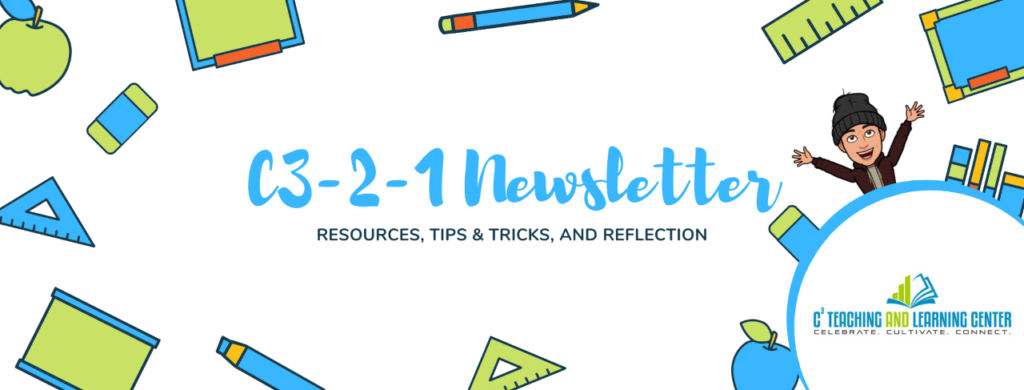C3-2-1 Newsletter – Week One of Fall 2020!!!
Hello, Faculty Community!
***You are receiving this newsletter because you are a faculty member at MiraCosta College. I, Sean Davis, am the coordinator of our C3 Teaching and Learning Center***
And away we go…
3 resources related to teaching and learning, 2 online tips and tricks, and 1 question for reflection
Want to share?
If you have some resources, tips/tricks, and questions to share, please contribute to the newsletter using this C3-2-1 Form.

(3) Resources
- PROJECT Online Teaching Foundations Canvas Course (click the link to self-enroll in the coursePROJECT stands for Professionals for Joy, Equity, and Community in Teaching. It’s our hope that you’ll find this course helps you to approach online teaching more joyfully, to prepare online classes that are equitable, and to engage with (as much as you are interested) a community of supportive colleagues. Faculty learning experiences under the PROJECT name are organized by MiraCosta faculty support groups, including the C3 Teaching and Learning Center, Professional Development Program, and Online Education.
- MiraCosta Library Support For Fall Research Instruction – Orientation Request FormOur librarians provide fantastic support for research projects. In addition to the library website, library databases, 24/7 live chat with librarians, and the Canvas Online Student Support Hub’s Library Section, Librarians are also available to create assignment-specific class research guides (Sample Class Guide 1, Sample Class Guide 2), a brief YouTube video (Sample YouTube Video), or teach a live 30-minute Zoom research orientation to your class.
- Teaching First-Generation College Students GuidebookIn collaboration with first-gen college students, the TASC’s (Tutoring and Academic Support Center) Academic Success Coaching Program has developed a guide for teaching and learning with first-generation college students. Here is a description of the resource – This guidebook is organized by deconstructing the narrative of the first-generation identity, followed by identifying characteristics of a first-generation college student. In addition, it includes culturally responsive and sustaining teaching practices for faculty to employ. These best practices facilitate the success of first-generation college students in the classroom. Furthermore, we describe social capital in the community college context.
For more context, please take the time to watch this 10-minute documentary on our First-Gen Students
(2) Online Tips and Tricks
- Using Google Voice as a tool for connecting with students If you want to connect with students via phone/text but don’t want to give your personal number, try this resource. This free product will generate a local phone number that you can use to avoid unwanted clutter on your own text message app and phone. The texts and calls using your Google Phone Number will be pushed to your phone through the app.
- Setting Up Notifications as an Instructor in CanvasCanvas can provide you with notifications about updates and changes to your course by sending you an email, text, and other communication forms. You can change the default notification settings to get the information you want in the ways you prefer. These changes only apply to you so if you want to let students know how to set their notification preferences, provide them with this resource – Student Notification Guide
(1) Question
Are we giving our students and ourselves the time and space to acclimate to all the new things?
Stay Joyful,
Sean Davis
Joyful Teacher in Residence J
Coordinator, C3 Teaching and Learning Center

Oceanside Campus
1 Barnard Drive
Oceanside, CA 92056
P 760.757.2121 x7713
C 760.521.1387
sdavis@miracosta.edu

